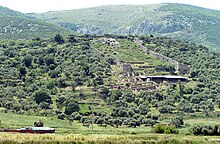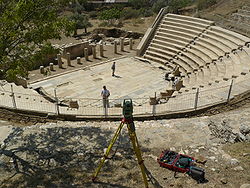Metropolis (Anatolia)
Μητρόπολις | |
 The city's ruins as seen from the east. | |
| Alternative name | Bademgediği Tepe |
|---|---|
| Location | Yeniköy, İzmir Province, Turkey |
| Region | Ionia |
| Coordinates | 38°07′30″N 27°19′21″E / 38.12500°N 27.32250°E |
| Type | Settlement |
Metropolis (
It is often referred to as the "City of the
History
The earliest known settlement at the site is from the Neolithic showing evidence of contact and influence with the Troy I littoral culture.[citation needed]
Late Bronze Age
The city seems to be referred to as Puranda in the Annals of
Mycenaean remains are also found.[5] Bademgedigi Tepe is the archaeological site in the area with large amounts of local Mycenaean pottery, ranging from the 14th to 12th century BC, and later.[6][7] A Mycenaean-age representation of a ship on a vase from Bademgediği Tepe is an important find that casts light on the development of ship technology and iconography on ceramic vessels.[8]
Hellenistic Period
Metropolis was a part of the

The city was noted by numerous classical authors including
What is visible today is primarily a Hellenistic city heavily Romanised, and with Byzantine remains laid across it – a church to the east of the city, and fortification walls laid across the city that connect to the Hellenistic defenses on the Acropolis.
Excavations
The city was first investigated through archaeological field work from 1972 by Professor Recep Meriç from the Dokuz Eylül University, İzmir. Metropolis has been excavated since 1989.[15]
In 1995, archaeologists discovered a
In June 2021, archaeologists announced the discovery of a well-preserved 1,800-year-old marble statue of a woman standing on a pedestal in Torbalı district. The head and two arms of the statue were missing.[17][18][19][20]
Notes
- ^ Meriç, R., Metropolis, City of the Mother Goddess, İstanbul, 2003
- ^ Aybek, S., Ekin Meriç, A., Öz, A. K., Metropolis: A Mother Goddess City in Ionia, İstanbul, 2009
- ^ Hawkins, J. D. 2009. The Arzawa letters in recent perspective. British Museum Studies in Ancient Egypt and Sudan 14:73–83
- ^ Mommsen, H., et al., "BADEMGEDIǦI TEPE: ITS RELATIONS WITHIN THE EAST AEGEAN-WEST ANATOLIAN INTERFACE, AND BEYOND. NEW INFORMATION FROM NEUTRON ACTIVATION ANALYSIS", Ägypten Und Levante / Egypt and the Levant, vol. 31, pp. 357–90, 2021
- ^ Meriç, R., Mountjoy, P., “Three Mycenaean Vases from Ionia”, Istanbuler Mitteilungen, 51, 2001, s. 133-137
- ^ Jorrit Kelder (2006), Mycenaeans in Western Anatolia academia.edu
- ^ Meriç, R., Mountjoy, P. (2002), “Mycenaean Pottery from Bademgedigi Tepe (Puranda) in Ionia: A Preliminary Report.” Istanbul Mitteilungen 52:79–98
- ^ Millington, A.T. (2013) “Iyarri at the Interface: The Origins of Ares” in A. Mouton, I. Rutherford, & I. Yakubovich (eds.) Luwian Identities: Culture, Language and Religion Between Anatolia and the Aegean (Leiden) pp.555-557
- Geography, XIV, i, 2; XIV i, 15.
- ^ Ptol., Geography, 5.2.17.
- Geography, XIV i, 15.
- ^ Steph. B., Ethnica, s.v.
- ^ Hierocl., Synecdemus, p. 600.
- ^ Meriç, R., Metropolis, City of the Mother Goddess, İstanbul, 2003
- ^ Theater of ancient Metropolis crowned with reproduction of griffin seat
- ^ "1,800-year-old statue found in ancient Metropolis". Hürriyet Daily News. 13 June 2021. Retrieved 2021-09-04.
- ^ Gershon, Livia. "Headless Statue of Ancient Woman Discovered in Turkey's 'Mother Goddess City'". Smithsonian Magazine. Retrieved 2021-09-04.
- ^ Holth, Jesse (2021-06-24). "1,800-Year-Old Statue Found in Ancient "City of the Mother Goddess" in Turkey". ARTnews.com. Retrieved 2021-09-04.
- ^ Büyükyıldırım, Oğuz, 1,800 Years Old Woman Sculpture in the Ancient City of Metropolis, Arkeonews, June 16, 2021
![]() This article incorporates text from a publication now in the public domain: Smith, William, ed. (1854–1857). "Metropolis". Dictionary of Greek and Roman Geography. London: John Murray.
This article incorporates text from a publication now in the public domain: Smith, William, ed. (1854–1857). "Metropolis". Dictionary of Greek and Roman Geography. London: John Murray.
Bibliography
Books
- Aybek, S., Metropolis İonia I: Heykel, Metropolis'de Hellenistik ve Roma Dönemi Heykeltıraşlığı, İstanbul, 2009.
- Aybek, S., Ekin Meriç, A., Öz, A. K., Metropolis: A Mother Goddess City in Ionia, İstanbul, 2009.
- Aybek, S., Ekin Meriç, A., Öz, A. K., Metropolis: İonia'da Bir Ana Tanrıça Kenti, İstanbul, 2009.
- Meriç, R., Metropolis, City of the Mother Goddess, İstanbul, 2003.
- Meriç, R., Metropolis, Ana Tanrıça Kenti, İstanbul, 2003.
- Meriç, R., Späthellenistisch-römische Keramik und Kleinfunde aus einem Scachtbrunnen am Staatsmarkt in Ephesos, Wien, 2002.
- Meriç, R., Metropolis Kazılarının İlk 5 Yılı, İstanbul, 1996.
- Meriç, R., Metropolis, İstanbul, 1992.
- Meriç, R., Metropolis in Ionien: Ergebnisse einer Survey-Unternehmung in den Jahren 1972–1975, Königstein, 1982.
Articles
- Herling, L., Kasper, K., Lichter, C., Meriç, R., Im Westen nichts Neues? Ergebnisse der Grabungen 2003–2004 in Dedecik-Heybelitepe, Istanbuler Mitteilungen, 58, s. 13-65, 2008.
- Meriç, R., “Metropolis”, W. Radt ed. içinde, Byzas 3; Stadtgrabungen und Stadtforschung im westlichen Kleinasien, 2006, s. 227-240.
- Meriç, R., “Excavation at Bademgeiği Tepe (Puranda) 1999–2002: A Preliminary Report, Istanbuler Mitteilungen, 2003, s. 79-98.
- Meriç, R., Mountjoy, P., “Three Mycenaean Vases from Ionia”, Istanbuler Mitteilungen, 51, 2001, s. 133-137.
- Meriç, R., Mountjoy, P. (2002), “Mycenaean Pottery from Bademgedigi Tepe (Puranda) in Ionia: A Preliminary Report.” Istanbul Mitteilungen 52:79–98
- Meriç, R., Schachner, A., “Ein Stempelsiegel des spaeten 2. Jahrtausends v. Chr. aus Metropolis in Ionien”, Studi Micenei ed Egeo-Anatolici, XLII/1-2000, s. 85-102.


